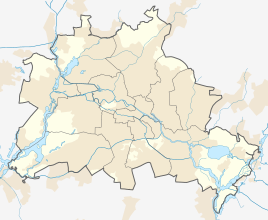Cockchafer barracks
|
|
|||
|---|---|---|---|

postcard |
|||
| country | Germany | ||
| local community | Berlin | ||
| Coordinates : | 52 ° 32 ' N , 13 ° 23' E | ||
| Opened | 1849 to 1851 | ||
| owner | Federation | ||
| Formerly stationed units | |||
| Guard Fusilier Regiment |
|
||
|
Location of the cockchafer barracks in Berlin |
|||
The cockchafer barracks was the barracks of the Guard Fusilier Regiment of the Prussian Army on Chausseestrasse in Berlin from 1851 to 1918 . This regiment was due to their uniform and the beetle called , thus the name transferred to the barracks.
history
From 1851 to 1918 the Guard Fusilier Regiment had its garrison in Berlin's Chausseestrasse 89–92 and Kesselstrasse 1–2. In front of the barracks gate was the saying: "Long live the regiment that proudly calls itself cockchafer."
The barracks were built from 1849 to 1851, including the remains of the officers' mess of the artillery wagon houses that burned down on the night of March 18, 1848 as "barracks in front of the Oranienburger Tor". The three buildings, one behind the other on Chausseestrasse, each served to accommodate a battalion . The buildings were built in a peculiar way without a corridor. In front of and behind each middle wall were the team rooms with separate stair access. Each company had an enclosed area: large rooms that could be reached via a separate staircase. The plastered facades were square.
In 1915 Hans Leip served in the Guard Fusilier Regiment. In the guardroom of the cockchafer barracks he is said to have written the song Lili Marleen before leaving for the Eastern Front .
On 9 November 1918 the first day of the November Revolution , tried to break up demonstrators a barracks. After they succeeded, they stormed into the barracks yard. An officer shot the innkeeper Richard Glatte, the fitter Franz Schwengler and the tool fitter and Spartakist Erich Habersaath .
After the First World War it was used as a police barracks, and the parade ground was expanded to become a police sports field and a police stadium. In the Second World War, the barracks was destroyed except for a few outbuildings and demolished afterwards. From 1950 the Walter Ulbricht Stadium was built there and in May 1951 the “Kesselstraße” adjacent to the barracks was renamed “Habersaathstraße”.
The new headquarters of the Federal Intelligence Service (BND) has been built on the site since 2008 .
Web links
Individual evidence
- ↑ Cockchafer barracks. Retrieved August 26, 2019 .
- ^ Gotthold Schramm: The BND headquarters in Berlin . edition ost, 2012, ISBN 978-3-360-51001-3 ( google.at [accessed on August 26, 2019]).
- ↑ Chausseestrasse. Retrieved on August 26, 2019 (German).
- ↑ There was the lantern in front of the great gate. Retrieved August 26, 2019 .
- ^ Frankfurter Zeitung November 10, 1918: Scheidemann proclaims the republic . ISSN 0174-4909 ( faz.net [accessed August 26, 2019]).
- ↑ 100 years of revolution - Berlin 1918/19 | Cockchafer barracks. Retrieved August 26, 2019 .
- ↑ Memorial plaques in Berlin - Memorial plaque advertisement. Retrieved August 26, 2019 .
- ↑ Exploded costs: opening of the BND headquarters overshadowed by criticism. Retrieved August 26, 2019 .


